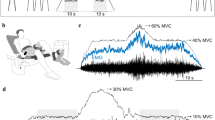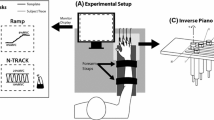Abstract
The targeted flexor isometric force steps developed by a wrist and corresponding EMG activity of the flexor muscles were studied in healthy volunteers. In 82.3–97.5% of trials, the main component of the force trajectory (before the postcorrections of the force level) showed complex dynamics: several (from two to five)dF/dt peaks were observed at this section of the trajectory. The distribution of time intervals from the initiation of the force trajectory todF/dt peaks was polymodal in all cases. The mean interval between successivedF/dt peaks varied from 56.7 msec to 84.4 msec in different individuals (the average group value was 70.5 msec). All tested subjects exhibited amplitude modulation of integrated EMG at the section reflecting the force step development; the averaged interval between the successive first-order EMG peaks calculated for the group of five persons was 78.6 msec. Strict temporal correlation ofdF/dt peaks and EMG peaks was found (coefficient of correlation averaged 0.94). It is concluded that the motor command ensuring performance of isometric force step includes a cyclic component; this feature must be taken into account when mechanisms controlling such motor events are interpreted. The frequency of the component is near the upper limit of a normal tremor frequency band. At the same time, it is impossible to regard the cyclic component in the motor command as a result of simple superposition of tremor on the targeted force development because the cyclic component is clearly synchronized with the force step initiation.
Similar content being viewed by others
References
C. Ghez and J. Gordon, “Trajectory control in targeted force impulses. I. Role of opposing muscles,”Exp. Brain Res.,67, No. 2, 225–240 (1987).
P. I. Cordo, “Mechanisms controlling accurate changes in elbow torque in humans,”J. Neurosci.,7, No. 2, 432–442 (1987).
J. Gordon and C. Ghez, “Trajectory control in targeted force impulses. II. Pulse height control,”Exp. Brain Res.,67, No. 2, 241–252 (1987).
K. M. Newell and L. G. Carlton, “On the relationship between peak force and peak force variability in isometric tasks,”J. Mot. Behav.,17, No. 2, 230–241 (1985).
V. Ya. Pyatigorskii, D. A. Vasilenko, and A. É. Ivanov, “The targeted force steps developed by a human wrist: the force trajectories under conditions of repetition and random alternation of various target levels,”Neirofiziologiya/Neurophysiology,25, No. 5, 389–399 (1993).
J. Desmedt and E. Godaux, “Ballistic contractions in fast or slow human muscles: discharge patterns of single motor units,”J. Physiol.,285, 185–196 (1978).
B. E. Mustard and R. G. Lee, “Relationship between EMG patterns and kinematic properties for flexion movements at the human wrist,”Exp. Brain Res.,66, No. 2, 247–256 (1987).
H.-M. Meinck, R. Benrke, W. Meyer, et al., “Human ballistic finger flexion: incoupling of the three-burst pattern,”Exp. Brain Res.,55, No. 1, 127–133 (1984).
V. Ya. Pyatigorskii and A. É. Ivanov, “The isometric force responses developed by a human wrist: the force trajectories in the presence or absence of a visual target,”Neirofiziologiya,23, No. 1, 25–34 (1991).
O. C. J. Lippold, “Oscillation in the stretch reflex arc and the origin of the rhythmical 8–12 c/s component of physiological tremor,”J. Physiol.,206, 359–382 (1970).
O. C. J. Lippold,The Origin of the Alpha Rhythm, Churchill Livingstone, Edinburgh, London (1973).
K. Gometz and A. Tailor, “Spectral analysis of the demodulated EMG in isometric and isotonic human muscle contraction,”J. Physiol.,418, 105 (1989).
R. J. Jaeger, G. L. Gottlieb, and G. C. Agraval, “Myoelectric responses at flexors and extensors of human wrist to step torque perturbations,”J. Neurophysiol.,48, No. 2, 388–402 (1982).
R. J. Jaeger, G. L. Gottlieb, G. C. Agraval, and A. J. Tahmoush, “Afferent contributions to stretch-evoked myoelectric responses,”J. Neurophysiol.,48, No. 2, 403–418 (1982).
Ye. A. Andreeva and O. E. Khutorskaya,Spectral Method in Analysis of Electrical Activity of Muscles [in Russian], Nauka, Moscow (1987).
V. S. Gurfinkel' and Yu. S. Levik, “Dependence of muscle contraction on the order of stimulation pulses,”Biofizika,18, No. 1, 116–121 (1973).
R. B. Stein and F. Parmiggiani, “Optimal motor patterns for activation mammalian muscle,”Brain Res.,70, No. 3, 779–793 (1979).
Author information
Authors and Affiliations
Additional information
Neirofiziologiya/Neurophysiology, Vol. 25, No. 6, pp. 455–462, November–December, 1993.
Rights and permissions
About this article
Cite this article
Vasilenko, D.A., Pyatigorskii, B.Y., Ivanov, A.É. et al. The targeted force steps developed by a human wrist: Cyclic components in the motor program. Neurophysiology 25, 378–383 (1993). https://doi.org/10.1007/BF01053215
Received:
Issue Date:
DOI: https://doi.org/10.1007/BF01053215




